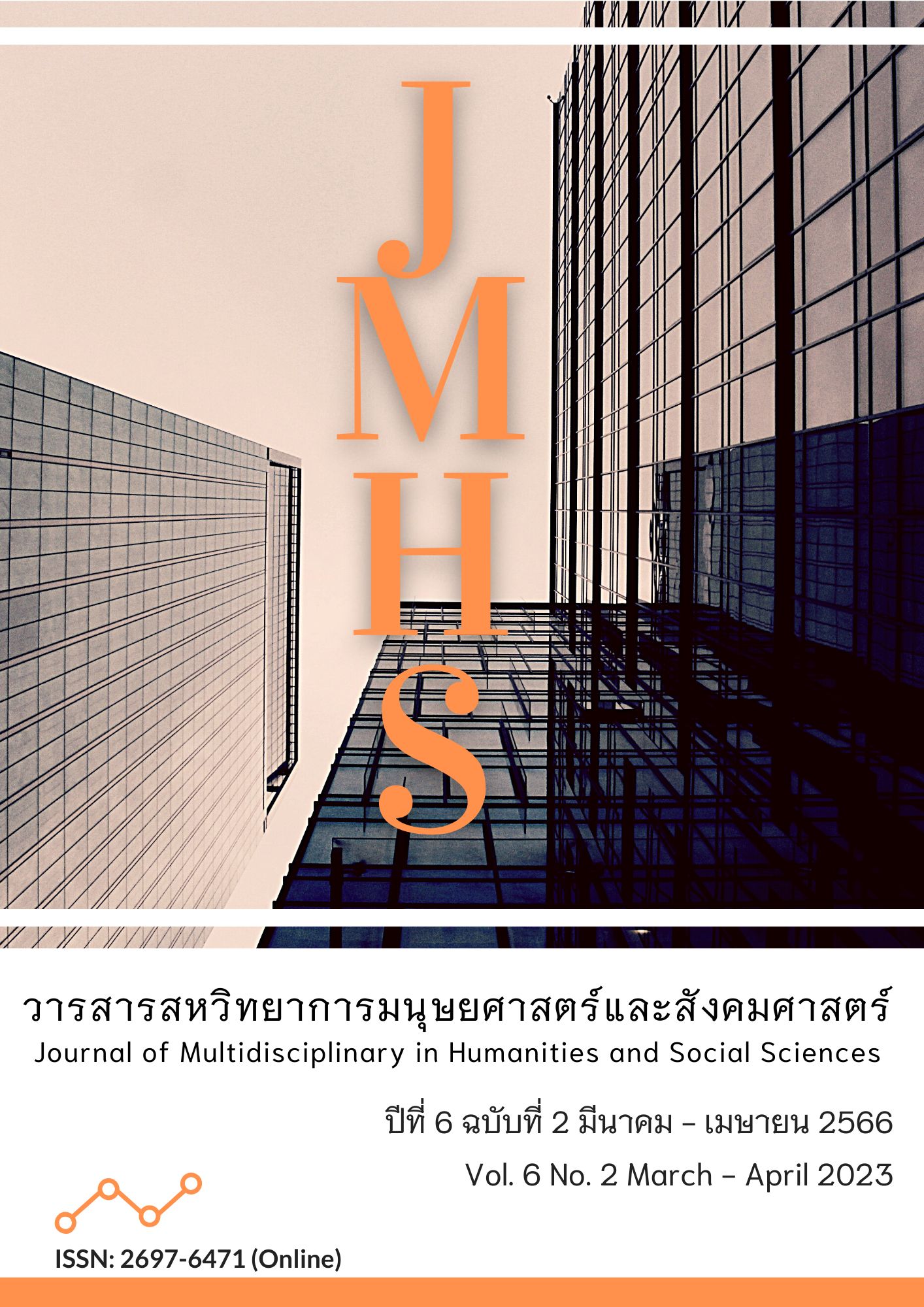Ethnic Social and Cultural Background to Transmitted Through Identity on Wenshan Hmong Embroidery Products
Main Article Content
Abstract
Wenshan is an autonomous region of the Zhuang and Hmong people. The People’s Republic of China The traditional society of Wenshan Hmong villages also had the influence of “cultural networks," which arise from the factors of people with knowledge in rural areas, folk beliefs, social organization, etc. These factors are related and interrelated, and together they define the fundamental boundaries of rural self-government. In addition, there is a transfer of culture to pass on culture from generation to generation by people with knowledge and ability about culture. By creating an identity from “raw materials” that exist in the context of that society to create and forge identity and identity, in this case, embroidered fabric, which is considered an important “raw material” for creating identity and identity of the Hmong people. Hmong embroidery is therefore important to reflect the way of life and cultural stories of Hmong women that have been handed down from generation to generation for hundreds of years. To be used to decorate various areas of clothing with artistic patterns on Hmong tribal cloth, including embroidery, sewing, and writing on candles. Both are traditional patterns that are unique and have been handed down since the ancestors. Patterns that are created from imagination imitate nature, the surrounding environment, a way of life; patterns that are influenced by beliefs, legends, or stories; and patterns that have been adapted to the era according to the needs of the consumer trend. While cultural identity is created through Hmong embroidery, it also leads to the dissemination of social values and culture that reflect the way of life of the Hmong. It can be considered a powerful soft power that can penetrate people tactfully and effectively.
Article Details

This work is licensed under a Creative Commons Attribution-NonCommercial-NoDerivatives 4.0 International License.
Views and opinions appearing in the Journal it is the responsibility of the author of the article, and does not constitute the view and responsibility of the editorial team.
References
เกศินี ศรีรัตน์. (2553). บทบาทของผ้าปักต่อวิถีชีวิตชาวม้งบ้านหนองหอย ต.แม่แรม อ.แม่ริม จ.เชียงใหม่. กรุงเทพฯ: สำนักงานคณะกรรมการวิจัยแห่งชาติ.
จันทนา ฟองทะเล. (2539). จากดอยยาวถึงภูผาจิ. (พิมพ์ครั้งที่ 2). กรุงเทพฯ: สมาพันธ์.
ชาย โพธิสิตา. (2548). การวิจัยเชิงคุณภาพ: ข้อพิจารณาทางทฤษฎี. ตำราประกอบการสอนและการวิจัยการศึกษาเชิงคุณภาพ เทคนิคการวิจัยภาคสนาม. (พิมพ์ครั้งที่ 6). นครปฐม: สถาบันวิจัยประชากรและสังคม, มหาวิทยาลัยมหิดล.
ประสิทธิ์ ลีปรีชา. (2549). ม้ง : หลากหลายชีวิตจากขุนเขาสู่เมือง. เชียงใหม่: สถาบันวิจัยสังคม มหาวิทยาลัยเชียงใหม่.
รังสรรค์ ธนพรพันธุ์. (2546). ทุนวัฒนธรรม : วัฒนธรรมในระบบทุนนิยมโลก. กรุงเทพฯ: มติชน.
วัฒน์ วรรลยางกูร. (2546). คิดถึงบ้านเกิด. กรุงเทพฯ: นานมีบุ๊คส์.
ศุภกิจ วงศ์วิวัฒนนุกิจ. (2550). พจนานุกรมศัพท์การวิจัยและสถิติ. กรุงเทพฯ: สำนักพิมพ์แห่งจุฬาลงกรณ์มหาวิทยาลัย.
สุธิษา ศรพรหม. (2559). การศึกษาและออกแบบผลิตภัณฑ์จากผ้าปักอัตลักษณ์ชาติพันธุ์ม้ง.วารสารวิชาการศิลปะสถาปัตยกรรมศาสตร์ มหาวิทยาลัยนเรศวร, 7(2), 111-123.
เสกสรรค์ ประเสริฐกุล. (2554). วันที่หัวใจกลับบ้าน : บทสำรวจพื้นที่ว่าง ณ ใจกลาง ป่าอารมณ์. กรุงเทพฯ: สามัญชน.
อลิศรา ศิริศรี. (2541). การนำวิธีวิจัยเชิงชาติพันธุ์วรรณนามาใช้ในการวิจัยทางการศึกษา. ในเอกสารรวมบทความทางวิธีวิทยาการวิจัย เล่ม 1 ชุดรวมบทความ เล่มที่ 16. (หน้า 249-257). กรุงเทพฯ: จุฬาลงกรณ์มหาวิทยาลัย.
Cole, P.G., & Chan, L.K.S. (1994). Teaching Principles and Practice. New York: Prentice Hall.
Foucault, M. (1988). Technologies of the self. In L.H. Martin, H. Gutman, & P. H. Hutton, Technologies of the Self: A Seminar with Michael Foucault. (pp. 16-49). London: Tavistock.
Duara, P. (1991). Culture, Power and The State: Rural North China, 1900-1942. Palo Alto: Stanford University Press.
Zijun, H. (2014). Give Full Play to The Leading Role of Rural Sages and Promote Modern Rural Governance. Hengyang: Hengyang Communication.


